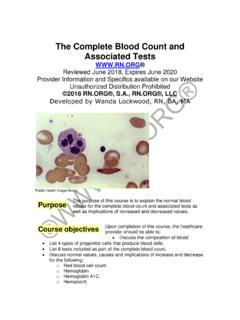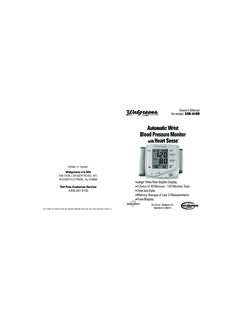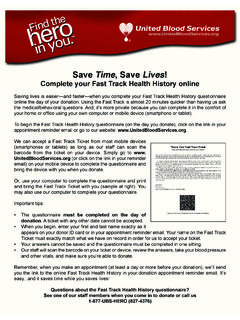Transcription of How to Interpret and Pursue an Abnormal …
1 Mayo Clin Proc. July 2005;80(7):923-936 complete blood CELL COUNTS IN ADULTSHow to Interpret and Pursue an AbnormalComplete blood Cell Count in AdultsCONCISE REVIEW FOR CLINICIANSAYALEW TEFFERI, MD; CURTIS A. HANSON, MD; AND DAVID J. INWARDS, MDA complete blood cell count (CBC) is one of the most commonlaboratory tests in medicine. For example, at our institution alone,approximately 1800 CBCs are ordered every day, and 10% to 20%of results are reported as Abnormal . Therefore, it is in everyclinician s interest to have some understanding of the specific testbasics as well as a structured action plan when confronted withabnormal CBC results.
2 In this article, we provide practical diagnos-tic algorithms that address frequently encountered conditions asso-ciated with CBC abnormalities including anemia, thrombocytope-nia, leukopenia, polycythemia, thrombocytosis, and objective is to help the nonhematologist recognize when asubspecialty consultation is reasonable and when it may be circum-vented, thus allowing a cost-effective and intellectually Clin Proc. 2005;80(7):923-936 ACD = anemia of chronic disease; ANC = absolute neutrophil count;CBC = complete blood cell count; CML = chronic myeloid leukemia;ET = essential thrombocythemia; FISH = fluorescence in situ hybridiza-tion; Hct = hematocrit; HES = hypereosinophilic syndrome; Hgb = hemo-globin; HIV = human immunodeficiency virus; IDA = iron deficiencyanemia; ITP = idiopathic thrombocytopenic purpura; LDH = lactate dehy-drogenase; LGL = large granular lymphocyte; MCV = mean corpuscularvolume; MDS = myelodysplastic syndrome; PA = pernicious anemia.
3 PBS = peripheral blood smear; PT = primary thrombocytosis; PV = poly-cythemia vera; RBC = red blood cell; RCM = RBC mass; RT = reactivethrombocytosis; TCR = T-cell receptor; TTP/HUS = thrombotic thrombo-cytopenic purpura/hemolytic uremic syndrome; WBC = white blood cellFrom the Department of Internal Medicine and Division of Hematology ( , ) and Department of Laboratory Medicine and Pathology and Division ofHematopathology ( ), Mayo Clinic College of Medicine, Rochester, question-and-answer section appears at the end of this reprints of this article are not available. Address correspondence toAyalew Tefferi, MD, Division of Hematology, Mayo Clinic College of Medicine,200 First St SW, Rochester, MN 55905 (e-mail: 2005 Mayo Foundation for Medical Education and ResearchCirculating blood cells, including red blood cells(RBCs), white blood cells (WBCs), and platelets, arecounted and sized electronically by modern ,2 One such instrument, the Coulter counter, generates anelectrical pulse when a blood cell passes through a smallaperture surrounded by electrodes.)
4 Each electrical pulse re-presents an individual cell, and the pulse height indicates thecell volume. Therefore, the electronic counter not only regis-ters the total cell count but also estimates the average cellvolume and the variation in cell size. In the context of RBCs,for example, these measurements are referred to as the meancorpuscular volume (MCV) and the RBC distribution width,respectively. Modern electronic counters are also capable ofmultimodal assessment of cell size and content, thus provid-ing additional information about the various categories ofWBCs including neutrophils, lymphocytes, monocytes,eosinophils, and basophils (ie, 5-part differential).
5 Two other measured variables of the complete bloodcell count (CBC) are hemoglobin (Hgb) and hematocrit(Hct). Both provide equivalent information, approximatelyconveyed by the RBC count, and are ,4 TheHgb is computed by a spectrophotometer after RBCs arelysed in a given volume of blood and the Hgb is chemicallyconverted into a stable pigment. The Hct is determined by amicrohematocrit centrifuge and represents the percentage ofa given volume of whole blood that is occupied by ,6 However, Hct also can be calculated by multiply-ing the RBC count and the MCV. Other calculated vari-ables in the CBC include the mean corpuscular Hgb con-tent (Hgb 1/RBC count) and mean corpuscular Hgbconcentration (Hgb 1/Hct).
6 These 2 calculated values arerarely used in routine clinical practical purposes, the variables to focus on whenexamining the CBC are Hgb (as a general indicator ofanemia or polycythemia), MCV (a key parameter for theclassification of anemias), RBC distribution width (a rela-tively useful parameter in the differential diagnosis of ane-mia), RBC count (an increased RBC count associated withanemia is characteristic in the thalassemia trait), plateletcount (to detect either thrombocytopenia or thrombo-cythemia), and WBC count with differential (usually givesimportant clues for the diagnosis of acute leukemia andchronic lymphoid or myeloid disorders as well as for thepresence of leukopenia and neutropenia).
7 Furthermore, inpatients with an Abnormal WBC count, the clinician shouldimmediately ask which WBC type is affected: neutrophils,lymphocytes, monocytes, eosinophils, or basophils. In thisregard, the machine-derived 5-part differential should beconfirmed by the human eye (ie, peripheral blood smear[PBS] examination) before it is acted , an Abnormal CBC should be interpretedwithin the context of an individual s baseline value becauseup to 5% of the general population without disease maydisplay laboratory values outside the statistically assigned normal reference range7 (Table 18,9).
8 Likewise, an indi-vidual may display a substantial change from his or herbaseline (ie, personal normal) without violating the nor-mal reference range. Similarly, differences in the CBCbased on race and sex should be considered when Interpret -ing results. In general, RBC-associated measurements arelower and platelet counts are higher in women comparedFor personal use. Mass reproduce only with permission from Mayo Clinic personal use. Mass reproduce only with permission from Mayo Clinic Clin Proc. July 2005;80(7):923-936 complete blood CELL COUNTS IN ADULTSTABLE 1.
9 Reference Ranges of complete blood Cell Count inAdult White Persons and Persons of African Ancestry*WhiteAfricanVariableMaleFemaleM aleFemaleHemoglobin9 (g/dL) ( )( )RBCs9 ( 1012/L) ( )( )Mean (fL)( )( )RBC distribution width (%)( )( )Platelets8 ( 109/L)143-332169-358115-290125-342(150-4 50)(150-450)WBCs8 ( 109/L) ( )( )Neutrophils8 ( 109/L) ( )( )Lymphocytes8 ( 109/L) ( )( )Monocytes8 ( 109/L) ( )( )Eosinophils8 ( 109/L) ( )( )Basophils ( 109/L)( )( )*Abstracted from population-based studies from Bain8 and Mayo Clinicnormal values, based primarily on white subjects, are in parentheses for comparison.
10 RBC =red blood cell; WBC = white blood men, and persons of African ancestry display signifi-cantly lower Hgb, WBC, neutrophil, and platelet countsthan white ,9 ANEMIAThe first step in approaching anemia is to classify theprocess as microcytic (MCV, <80 fL), normocytic (MCV,80-100 fL), or macrocytic (MCV, >100 fL).10,11 This exer-cise markedly narrows the differential diagnosis that needsto be considered in each patient. Also, we strongly recom-mend obtaining a PBS during the initial evaluation of ane-mia, regardless of subtype. A PBS substantially enhancesthe initial process of differential diagnosis and providesguidance for further ANEMIAThe 3 major diagnostic possibilities for microcytic anemiaare iron deficiency anemia (IDA), thalassemia, and anemiaof chronic disease (ACD).






